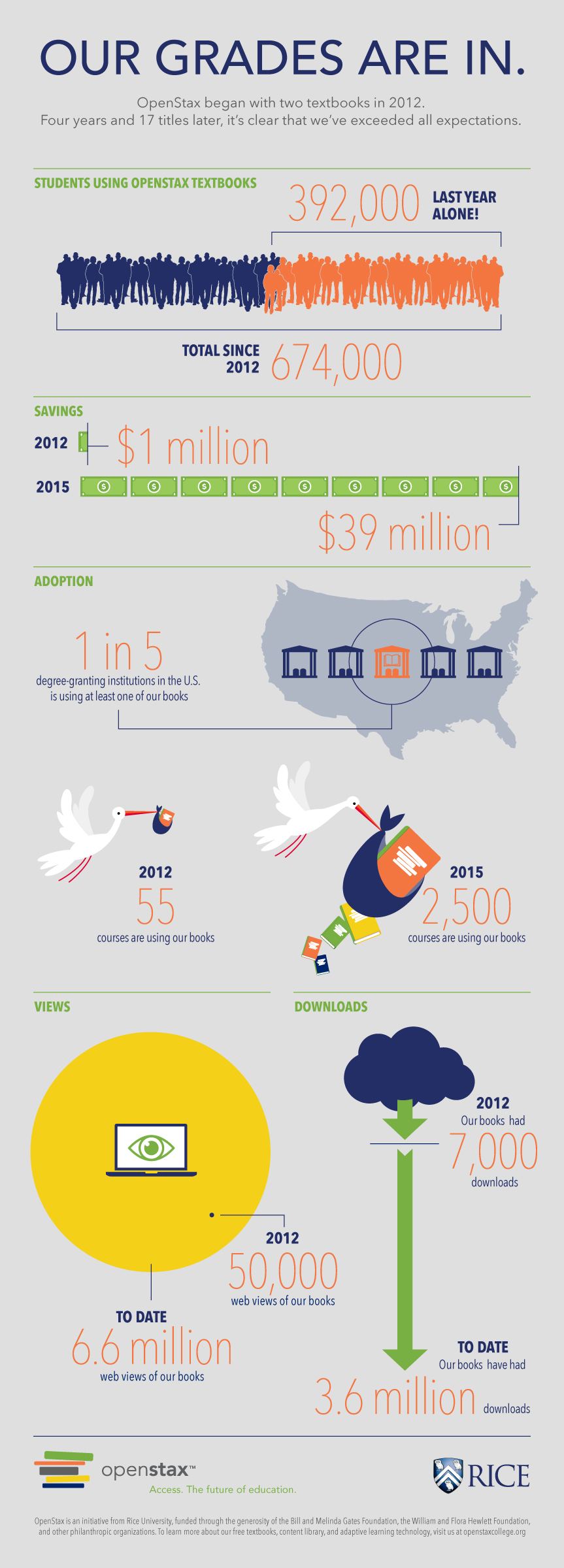Publisher’s free textbooks now used at one-in-five US colleges, universities
Free textbooks from Rice University-based publisher OpenStax are now in use at one-in-five degree-granting U.S. colleges and universities and have already saved college students $39 million in the 2015-16 academic year.

Free textbooks from Rice University-based publisher OpenStax are now in use at one-in-five degree-granting U.S. colleges and universities and have already saved college students $39 million in the 2015-2016 academic year. Credit: OpenStax/Rice University
“The number of instructors adopting our textbooks increased by more than 100 percent in 2015, and OpenStax college books are in use in 2,500 courses this academic year,” said Richard Baraniuk, founder and director of OpenStax and Rice’s Victor E. Cameron Professor of Engineering. “Those numbers speak volumes about the demand for affordable high-quality textbooks, and they confirm what we’ve long known: Scalability is the key to changing textbook economics.”
Baraniuk said OpenStax’s full-color, peer-reviewed textbooks differ from the vast majority of traditionally produced open educational resources (OER) because OpenStax’s books are specifically designed to be easily adopted into almost any introductory college course.
“Scalability is central to our mission of driving learning and access,” he said. “Our books will be used by nearly 400,000 students this spring, and we have saved students more than $66 million dollars in less than four years.”
Baraniuk said OpenStax’s rapid, large-scale impact is due to its unique OER business model: OpenStax uses philanthropic grants to produce high-quality, peer-reviewed textbooks that are free online and low-cost in print. It launched in 2012 with the goal of publishing free textbooks for the nation’s 25 most-attended college courses and is on track to meet its goal of saving students $500 million by 2020.
Current titles include College Physics; Biology; Concepts of Biology; Anatomy and Physiology; Principles of Economics; Principles of Microeconomics; Principles of Macroeconomics; Introductory Statistics; Precalculus; Algebra and Trigonometry; College Algebra; Chemistry; U.S. History; Psychology; Introduction to Sociology 2e and Prealgebra.
“One of the great benefits of working with OpenStax, other than saving my students hundreds in textbook costs, is that it’s easy to mix and match materials,” said Melissa Barlett, a life and health sciences instructor at Mohawk Valley Community College in New York. “For example, we have combined introductory material from Concepts of Biology with materials from Anatomy and Physiology, along with online videos and other open resources to create a text for a nonmajors human biology course designed for psychology and human service majors.”
OpenStax plans to publish Elementary Algebra, Intermediate Algebra, Calculus, Microbiology and American Government online this spring, in time for course adoptions for fall 2016.
OpenStax is made possible by the support of the William and Flora Hewlett Foundation, the Laura and John Arnold Foundation, the Bill & Melinda Gates Foundation, the 20 Million Minds Foundation, the Maxfield Foundation, the Calvin K. Kanzanjian Foundation, the Bill and Stephanie Sick Fund and the Leon Lowenstein Foundation.


Leave a Reply